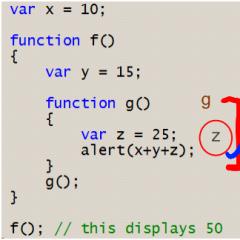Automatic login to Windows XP. Windows: Automatic login (autologin) Login to windows xp
Disabling the selection window user and automatic login without entering a password is convenient if you are the only user of the computer, or use a specific account much more often than others. When configuring automatic logon, you need to understand that anyone who turns on the computer will easily log in and gain access to all files and settings of the account used. The automatic logon setting differs depending on whether the computer is joined to a domain.
If you are using Windows XP, then most likely you will have to edit the Windows registry. Be careful, entering incorrect values may interfere with Windows operation.
To enable automatic login using Registry Editor, follow these steps:
- On the menu Start select Execute.
- In field Open type the command Regedt32 and press Enter.
- Find the section in the registry:
HKEY_LOCAL_MACHINESOFTWAREMicrosoftWindows NTCurrentVersionWinlogon
- Double click on DefaultUserName, enter your username and click OK.
- Double click on DefaultPassword, enter your password and press the button OK.Note. If the parameter DefaultPassword is missing, create it. To create a parameter, follow these steps:
- On the menu Edit Create And String parameter.
- Type DefaultPassword and press ENTER.
- Double-click the option DefaultPassword.
- Enter your password in the window and click the button OK.
Note. If the DefaultPassword parameter value is not specified, the system automatically changes the parameter value AutoAdminLogon from 1 (true) to 0 (false), thereby disabling automatic entry.
- On the menu Edit select commands sequentially Create And String parameter.
- Type AutoAdminLogon and press ENTER.
- Double-click the AutoAdminLogon option.
- In the window Changing a string parameter enter the value 1 and click the button OK.
- Close Registry Editor.
- Click the button Start, select item Shutdown and enter the reason in the field Note.
- Click the button OK to turn off the computer.
- Restart your computer. You are now logged in automatically.
Notes. To skip the automatic sign-in process and sign in as a different user, hold down the SHIFT key after you log out or restart Windows.
Changes made to the registry will not work if the server is configured with a Network Logon Screen Saver by Group Policy Object or local policy. After changing the policy so that it does not affect the server, the automatic login feature will work correctly.
In Microsoft Windows XP Home Edition and Microsoft Windows XP Professional, on a computer that is not part of a domain, you can also disable automatic logon without editing the registry. To do this, follow these steps:
- Click the Start button and select Run
- In the Open field, enter control userpasswords2 and click OK
The problem is solved in the same way on a computer with Windows 7:
Click on the keyboard Windows+R(or item Execute(Run) in the Start menu).
2. In the window that appears, enter control userpasswords2 and press Enter.

3. In the window that opens user accounts(User Accounts) tab Users(Users) select your account and uncheck the box Require username and password(Users must enter a user name and password to use this computer).

4. Click Apply(Apply).
5. In the window that opens Automatic login(Automatically Log On) there will be three fields:
- User (User name);
- Password;
- Confirm Password.
Enter your password in the field Password(Password) and again - in the field Confirmation(Confirm Password).
All. From the next system reboot, you will no longer need to enter your password. Logging into Windows 7 will happen automatically.
Today I will tell you about automatic login to windows 7 without entering a password. A very handy thing when you are tired of entering a password every time you turn on your computer, but at the same time you need to protect your computer from unauthorized access over the network.
This method is suitable for those who do not have physical access to the computer, such as your home computer. If you work in a large team and more than a dozen people can access your computer, then it is better not to enable automatic login. In general, as usual, we do everything wisely!
And so let's consider two options, for computers that are not included in the domain and for those computers that are in the domain.
Windows 7 automatic logon for non-domain computers
Press keyboard shortcut Win+R to open the window Execute” and enter the text in the field: control userpasswords2
 Click “ OK“. The User Account Control window will open. Place the mouse cursor on the user under whose credentials you are logging in, uncheck the “ Require username...
”
Click “ OK“. The User Account Control window will open. Place the mouse cursor on the user under whose credentials you are logging in, uncheck the “ Require username...
”

Click the “ Apply” and enter the current password of this user twice
 Ready! Now restart your computer and make sure that you are logged in without entering a password.
Ready! Now restart your computer and make sure that you are logged in without entering a password.
Windows 7 automatic logon for computers in a domain
It is not as easy to do as for computers outside the domain, but it is also not very difficult. Open registry ( Win+R –> regedit) and go to branch:
HKEY_LOCAL_MACHINE –> SOFTWARE –> Microsoft –> Windows NT –> CurrentVersion –> Winlogon
Opening the parameter AutoAdminLogon and change the value from 0 to 1 (thus allowing automatic login).
Parameter DefaultUserName must contain the username with which to automatically log in (in my case User)
Now, to add a parameter containing the user's password (there is none by default), right-click in the registry window and select “ Create — String parameter", Enter the title DefaultPassword, and in the Value field, enter the user's password.
In parameter “ DefaultDomainName” enter your domain name.
In the end you should get something like this:
 That's all! Restart your computer and if you did everything correctly, authorization will take place automatically, without entering a password. A
That's all! Restart your computer and if you did everything correctly, authorization will take place automatically, without entering a password. A
If in Windows one user other than the administrator, and he does not have a password, then login is automatic. But, if the user has a password or there are several users, a user selection window appears. How to make Did Windows automatically boot under a specific user account?
If the computer is not part of a domain
In this case, configure automatic login (autologon) you can use the command control userpasswords2 or netplwiz(Windows Vista and 7 only).
- Press “WIN+R” and type control userpasswords2, press enter or “OK”
- In the opened window "User accounts" uncheck the “ Require username and password". Click “ Apply”.
- In the window that opens “ Automatic login” must be entered Username: Password and password confirmation. You need to enter exactly the user whose account will be used for automatic login. Click “OK”.
- Close the user accounts window.
Also setting autologona can be done in the registry, as described below.

If the computer is part of a domain
Specify the domain when setting up using the command control userpasswords2 no possibility. The necessary settings must be made to the registry through the registry editor.
- Press “WIN+R”. Recruiting regedit. Press Enter or “OK”.
- In the registry editor that opens, find the registry key - “HKEY_LOCAL_MACHINESOFTWAREMicrosoftWindows NTCurrentVersionWinlogon.”
- In this registry section you must fill in the values of the following parameters. If they don't exist, you'll have to create them.

| Parameter | Parameter type | Required value | Note |
| DefaultUserName | string | Autologon username | |
| DefaultPassword | string | user password for autologon | If there is no password, leave the parameter value empty |
| AutoAdminLogon | string | 1 | Autologon enabled |
| DefaultDomainName | string | Domain | The name of the domain that the computer belongs to |
How to change user when autologin is enabled
If you need to change the user while the autologone or boot under another account, then when selecting “Logout” or when booting the PC, hold down the key Shift.
In the registry section described above there is another parameter related to autologon - ForceAutoLogon. If “1” is written in its value, you can change the user only by holding down the key Shift.
In password protected Windows XP Home or PRO version of the system, each user logs in with their own username and password in order to have full access to the computer running the operating system Windows. But also, user Windows or the administrator can login from the machine Windows XP, without knowing the original password, if they have lost or forgotten the username or password, through various bypasses or hacking methods.
Such as use DreamPackPL,bypassing the need login using a valid account or password, hacking or brute force to extract from Windows, passwords for different users or administrator accounts with Ophcrack2, or using the services of third parties such as login recovery into the system,search and recovery of username and password Windows. However, there is one simple way hack Windows XP system, if the computer owner is set to Windows XP, and forgot or did not set the password for the administrator account.
By default when installed, Windows XP has a built-in administrator account, which is equivalent to privileges in Linux or Unix, which do not contain a password. In other words, a hacker or any other person can simply enter Administrator as the username to log into Windows bypass the welcome screen lines with an empty password and get the full administrative access How administrator to PC from Windows. Even worse, most computer owners don't even know what administrator account and does it actually exist, it is not even mentioned when they create or set a password for administrator account.
So, this security vulnerability flaw provides an easy way to hack any computer with operating system Windows XP, even if the user forgot or simply did not set a password for the user ID administrator. The problem is that in normal welcome screens Windows XP where you select the username that is required to login, username Administrator not displayed or displayed. If you can't choose or choose administrator from the Login screen, then how are you going to login with the account administrator? Basically, the welcome screen in Windows XP Welcome , you can bypass it, just press the Ctrl-Alt-Del keys together twice in sequence, and you will be shown Login to Windows, a menu where you can specify a username and password. In the Username text box, enter "Administrator"(without quotes) and leave the Password field blank. Then click Enter or click on OK. If there is no password to protect the administrator account, or a blank password is set, you will be able to access Windows, with full administrator administrative rights.
You need to set up automatic login in Windows XP. This is done for various reasons:
- Mainly when one person uses the computer. By setting up automatic login, you no longer have to enter a password every time your operating system boots.
- In my case, an old laptop acts as a small server. And at startup you need to run some programs on this laptop.
Method 1: Using Autologon from Windows Sysinternals (Recommended)
There is an excellent Autologon program from the legendary Windows Sysinternals suite. Autologon is very easy to use.You just need to launch it, fill out the fields in the dialog box and click the Enable button. To disable automatic login, click Disable. You can pass the username, domain, and password as command line parameters:
autologon.exe user domain password If the computer is not in a domain, then instead of the domain you should specify the computer name.
The main advantage of this method. What the password is not stored explicitly in the registry.
Method 2: using the wizard
On Windows XP systems, on a computer that is not part of a domain, you can also enable automatic logon without editing the registry. To do this, follow these steps.Step 1: Click the Start button and select Run.
In the "Open" field, enter the command "control userpasswords2" and click OK.

Step 2: Uncheck the "Require username and password" checkbox, and then click the "Apply" button.

Step 3. In the "Automatic Login" window, enter the user name (filled in automatically by the selected user from the "User Accounts" window in the previous step) and password:

Click OK to close the Automatic Logon window, and then click OK again to close the User Accounts window.
You can get overwhelmed and contemplate the results of your actions.
Method 3: Editing the Registry
This method requires manual editing of the registry.Step 1. Click the "Start" button, select "Run," type "regedit" into the command line and click "OK."
Step 2: Locate the following registry key:
HKEY_LOCAL_MACHINE\SOFTWARE\Microsoft\Windows NT\CurrentVersion\Winlogon
Step 3: Double-click the "DefaultUserName" option, enter your username, and click "OK."
Step 4: Double-click the DefaultPassword option, enter your password in the Value field, and click OK.
If the DefaultPassword parameter is missing, create it. To do this, follow these steps:
4a. From the Registry Editor's Edit menu, select New and then String Value.
Specify the parameter name as DefaultPassword and press ENTER.
4b. Double-click the created parameter and enter the password in the Value field.
Note. If the DefaultPassword registry entry does not exist, Windows XP will automatically change the value of the AutoAdminLogon registry key from 1 (true) to 0 (false). This will disable the AutoAdminLogon feature after you restart your computer.
Step 5: Double-click AutoAdminLogon, enter 1 in the Value field, and click OK.
If the AutoAdminLogon parameter is missing, create it. To do this, follow these steps:
5a. From the Registry Editor's Edit menu, select New and then String Value.
Set the parameter name to AutoAdminLogon and press ENTER.
5b. Double-click the created parameter and enter the number 1 in the Value field.
Step 6: Close Registry Editor and restart your computer.
After you restart your computer, you are automatically logged in.
Shutdown
To bypass the automatic logon procedure or log in as a different user, hold down the SHIFT key while starting Windows XP. This only changes the first login procedure.To apply the modified procedure in the future, the administrator must configure the following registry setting:
HKEY_LOCAL_MACHINE\SOFTWARE\Microsoft\Windows NT\CurrentVersion\Winlogon Parameter:ForceAutoLogon Type: REG_SZ Data: 1



